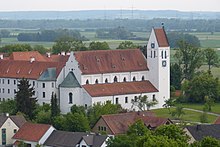St. Peter and Paul (Thierhaupten)
The former Benedictine abbey church and today's parish church of St. Peter and Paul in Thierhaupten , a market town in the Bavarian-Swabian district of Augsburg , is a protected architectural monument.
history
Around 1170, the then abbot Heinrich ordered the construction of today's abbey church of the Thierhaupten monastery, founded in the 8th century . The sacristy and the south aisle were added in 1309. After a fire in 1504, the western tower was demolished. The side apses were removed around 1590. The basilica , which is essentially Romanesque , was given a Baroque interior together with the convent and economic buildings around 1714 according to plans by Johann Jakob Herkommer . The sacristy chapel was built between 1762 and 1765.
The monastery was dissolved after secularization in 1803. The monastery church was bought by the last abbot Edmund Schmid, who served as the local pastor until his death, and donated it to the community. The service was resumed on October 2, 1812. In 1819 the parish church of St. Georg in the center of the village, which was incorporated into the monastery, was demolished. It was first mentioned in a document in 1334, rebuilt in 1599 and restored after a fire in 1696. The St. Georg cemetery still bears witness to the church. As a replacement, the former abbey church was converted into a parish church. A comprehensive renovation took place from 1947 to 1950.
description
The church is a three-aisled pillar basilica without a transept with a western tower with a gable roof, baroque extension and addition of the sacristy chapel.
Furnishing
The stucco work from around 1765 comes from Franz Xaver Feichtmayr the Elder. J . Franz Joseph Maucher from Friedberg created the ceiling frescoes in 1764. The choir fresco shows Peter and Paul in glory . The nave walls were repainted in 1956 by Richard Holzner. The church has five altars. The high altar dates from around 1700. The altar sheet with the theme of Mary flanked by Peter and Paul was painted by Johann Georg Knappich from Augsburg. The side altars are the Joseph Altar , the Scholastica Altar , the Marien Altar with the late Gothic Madonna around 1480 and the Benedictine Altar . Feichtmayr also created the rococo pulpit. The organ prospectus from around 1704 is attributed to Johann Fux from Donauwörth and the organ works in 1906 from Julius Schwarzbauer from Mindelheim.
Peal
Until the post-war period, the church tower only had a so-called weather bell, which was cast by Gregor Löffler in 1543 . The stroke inscription reads: "Abbot johannes Rumpfhart has zv praise Got dise Gloggen let pour. Ain sveßen klanng I give, The vest of the holy furnace I, the doten pevain I, the living for me, the cousin prich I". All other bells come from the Erdinger bell foundry and were made in 1953. The tone sequence is: h ° -e¹-fis¹-gis¹-h¹-cis².
See also
literature
- Michael Petzet , Bernd-Peter Schaul: Monuments in Bavaria Swabia. Volume VII. Ed .: Bavarian State Office for Monument Preservation. Oldenbourg, Munich 1986, ISBN 3-486-52398-8 .
- Josef Gröpl: Come to my house: Ecumenical Church Leader in the Augsburg district. Wißner-Verlag, Augsburg 2019, pp. 346 - 352.
Web links
Individual evidence
- ↑ Thierhaupten Market | Monastery tours | . Retrieved February 21, 2020 .
- ↑ The monastery church of Thierhaupten - ST. Peter & Paul. Retrieved February 21, 2020 .
- ↑ Claus Braun: Abbot Edmund bought the monastery church back. Retrieved February 21, 2020 .
- ↑ Bavaria from the trunk to the state: Festschrift for Andreas Kraus on his 80th birthday . CH Beck, 2002, ISBN 978-3-406-10721-4 ( google.de [accessed on February 21, 2020]).
- ↑ Claus Braun: Thierhaupten was on fire 300 years ago. Retrieved February 21, 2020 .
- ^ House of Bavarian History - Monasteries in Bavaria. Retrieved February 21, 2020 .
- ↑ Organ brochures. Retrieved February 21, 2020 .
- ↑ Augsburger Allgemeine: The oldest bell. Retrieved February 21, 2020 .
- ^ Günther Grundmann: German Bell Atlas . Deutscher Kunstverlag, 1959 ( google.de [accessed February 21, 2020]).
Coordinates: 48 ° 33 ′ 41.4 ″ N , 10 ° 54 ′ 40.9 ″ E


